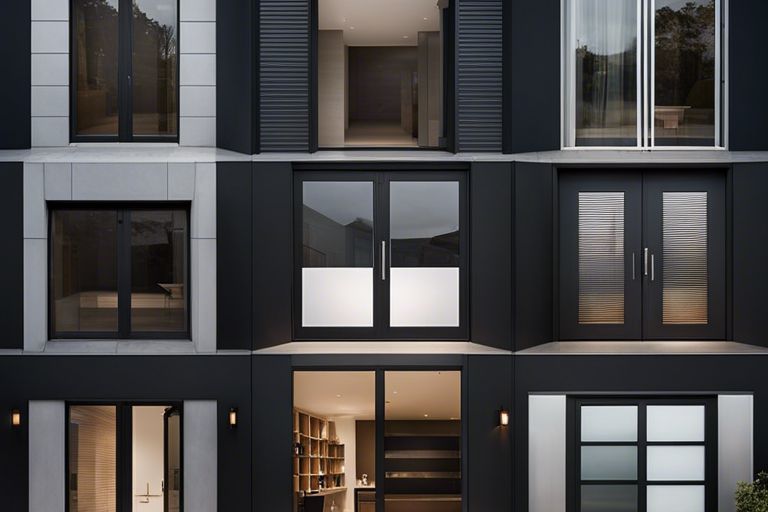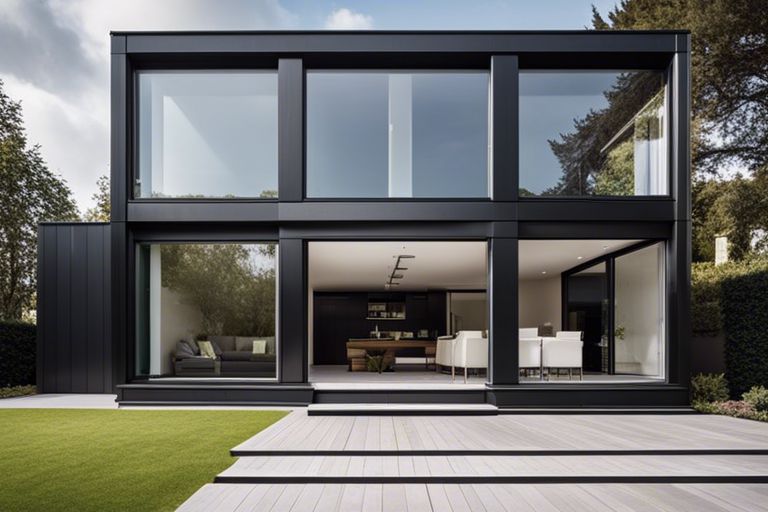Welcome to our informative blog post on understanding curtain walling. Curtain walling is a key element in modern architecture, providing aesthetic appeal, natural light, and energy efficiency to buildings. It is crucial to understand the importance of proper installation, as faulty curtain walling can lead to water leakage, thermal inefficiency, and structural issues. On the positive side, curtain walls offer flexibility in design, enhance the overall appearance of a building, and allow for creative architectural possibilities. By delving into the basics of curtain walling, we aim to equip you with the knowledge needed to appreciate this architectural feature and its significance in the construction industry.
Key Takeaways:
- Curtain walling is a non-structural cladding system used in modern architecture to create a building’s exterior envelope.
- Types of curtain walling include stick systems, unitised systems, and structural glazing, each with their own advantages and limitations.
- Benefits of curtain walling include improved natural lighting, thermal performance, and acoustic insulation, offering aesthetic appeal and sustainability to buildings.
Historical Development of Curtain Walls
Understanding the historical development of curtain walls is crucial to appreciating their significance in modern architecture. Curtain walls have evolved over centuries, adapting to changing architectural styles and technological advancements. This chapter researchs into the origins, evolution, and technological advancements that have shaped the development of curtain walls.
Origins and Evolution
The concept of curtain walls can be traced back to ancient civilizations such as the Egyptians and Romans, who used thin slabs of stone to create non-load-bearing walls. The evolution of curtain walls continued through the Gothic and Renaissance periods, where advancements in glass production allowed for larger windows and more intricate designs. The Industrial Revolution marked a significant turning point, with the introduction of iron and steel frames that supported expansive glass panels.
By the 20th century, curtain walls had become synonymous with modern skyscraper design, exemplifying the marriage of aesthetics and functionality. Architects like Mies van der Rohe and Le Corbusier pioneered the use of curtain walls in high-rise construction, pushing the boundaries of design and engineering.
Technological Advancements in Curtain Walling
With the advent of new materials such as aluminium and advancements in glass technology, curtain walls have become lighter, more energy-efficient, and structurally robust. The integration of double-glazed units, tinted glass, and insulated panels has significantly improved the performance of curtain walls in terms of thermal insulation and acoustic dampening.
Furthermore, developments in computer-aided design (CAD) and manufacturing processes have streamlined the production and installation of curtain wall systems. This has led to greater design flexibility, faster construction times, and enhanced quality control.

Types of Curtain Wall Systems
When it comes to curtain wall systems, there are two main types that are commonly used in the construction industry. These are Stick System Curtain Walls and Unitized Curtain Walls.
| Stick System Curtain Walls | Unitized Curtain Walls |
| Traditional method with components fabricated and assembled on-site | Pre-assembled in factory-controlled conditions |
| More flexibility in design changes during construction | Quicker installation due to pre-assembly |
| Labour-intensive installation on-site | Reduces on-site labour and construction time |
| Suitable for small to medium-sized projects | Ideal for large-scale projects with repetitive designs |
| Time-consuming process overall | Requires detailed planning and precision manufacturing |
Stick System Curtain Walls
Stick system curtain walls are a traditional method of curtain wall construction. In this system, the components are fabricated and assembled on-site, giving designers more flexibility in making design changes during the construction process. However, this method is labour-intensive and can be time-consuming.
One of the key benefits of stick system curtain walls is the ability to customise the design on-site if needed. This makes it suitable for small to medium-sized projects where design changes may occur during construction.
Unitized Curtain Walls
Unitized curtain walls offer a more modern approach to curtain wall construction. With components pre-assembled in factory-controlled conditions, the installation process is quicker and more efficient. This system is ideal for large-scale projects with repetitive designs.
Additionally, unitized curtain walls require detailed planning and precision manufacturing to ensure that the pre-assembled components fit together seamlessly. This method reduces on-site labour and construction time, making it a popular choice for many architects and builders.
After considering the differences between stick system and unitized curtain walls, it is important to choose the system that best suits the specific requirements of the project. Each system has its own set of advantages and limitations that need to be carefully evaluated before making a decision.

Design and Engineering Considerations
When it comes to curtain walling, design and engineering considerations play a crucial role in ensuring the success of a project. Architects and engineers must collaborate closely to achieve a balance between aesthetics, functionality, and structural integrity.
Structural Aspects of Curtain Walls
The structural aspects of curtain walls are essential for the overall stability and safety of the building. Factors such as wind loads, dead loads, seismic forces, and thermal expansion need to be carefully evaluated during the design phase. It is vital to select the right materials and framing systems to ensure that the curtain wall can withstand external pressures and maintain its integrity over time.
Additionally, the installation process of curtain walls must be meticulously planned to guarantee a secure and durable attachment to the building structure. This involves expert coordination between the design team, construction workers, and quality control inspectors to prevent any potential issues that could compromise the performance of the curtain wall.
Thermal Performance and Energy Efficiency
Thermal performance and energy efficiency are increasingly becoming key considerations in the design of curtain wall systems. By incorporating high-performance glazing and thermal breaks into the design, architects and engineers can significantly improve the building’s overall energy performance and reduce heat loss.
Furthermore, the orientation of the building and the use of shading devices can also impact the thermal performance of curtain walls. By carefully selecting materials and incorporating sustainable design principles, it is possible to achieve optimal energy efficiency while maintaining the aesthetic appeal of the building.
Installation and Maintenance
When it comes to curtain walling, proper installation and maintenance are crucial for the longevity and effectiveness of the system. From the initial installation to long-term upkeep, following best practices is vital to ensure the performance and safety of the curtain wall system.
Best Practices for Curtain Wall Installation
One of the key best practices for curtain wall installation is to engage experienced professionals who are trained in curtain wall systems. Proper training and expertise are essential to ensure the system is installed correctly, avoiding any risks of leaks, structural failures, or performance issues. Additionally, following manufacturer guidelines and specifications diligently during installation is paramount to guarantee the system’s integrity.
Regular inspection and quality control throughout the installation process are fundamental to identify and address any issues promptly. By conducting thorough checks at each stage of installation, any potential problems can be rectified early on, preventing costly damages or failures in the future.
Long-term Maintenance and Upkeep
Long-term maintenance and upkeep of curtain wall systems are essential to ensure they continue to function optimally and remain aesthetically pleasing. Scheduled inspections, cleaning, and maintenance routines are necessary to prevent issues such as sealant deterioration, water infiltration, or structural damage over time.
Regular cleaning of the curtain wall surfaces helps maintain their appearance and prevents the buildup of dirt, debris, or pollutants that can affect the system’s performance. Additionally, addressing any sealant or gasket failures promptly is crucial to prevent water leakage and maintain the system’s weatherproofing integrity.

Conclusion: Understanding Curtain Walling – An Introduction
Conclusively, this introductory guide sheds light on the importance and functionality of curtain walling in modern architectural design. By serving as a non-structural, aesthetically pleasing façade, curtain walls enhance the energy efficiency and natural light intake of buildings. Understanding the basics of curtain walling, from its materials and types to its installation process, is essential for architects, designers, and building professionals looking to incorporate this innovative system into their projects. With a deeper knowledge of curtain walling, professionals can create sustainable, visually appealing structures that meet the demands of contemporary architecture.
FAQ
Q: What is curtain walling?
A: Curtain walling is a non-structural cladding system for the external walls of buildings. It is designed to protect the building from the elements while enhancing its aesthetic appeal.
Q: How does curtain walling differ from traditional walls?
A: Curtain walling differs from traditional walls as it is not load-bearing. Instead, it hangs like a curtain from the building’s structure, providing an external envelope that is lightweight and versatile.
Q: What are the benefits of using curtain walling in construction?
A: Curtain walling allows for greater natural light penetration, energy efficiency, and design flexibility. It also provides weather resistance and can improve the overall sustainability of a building.






